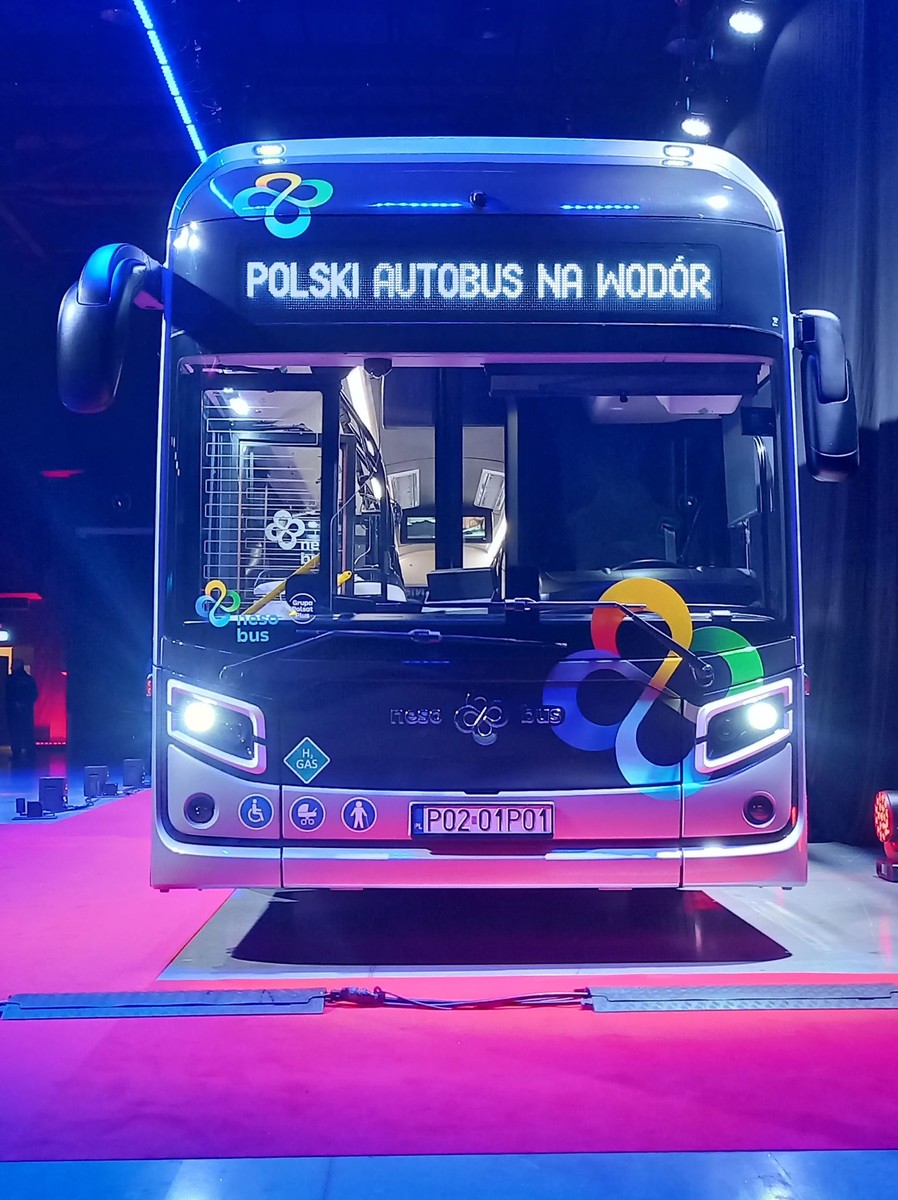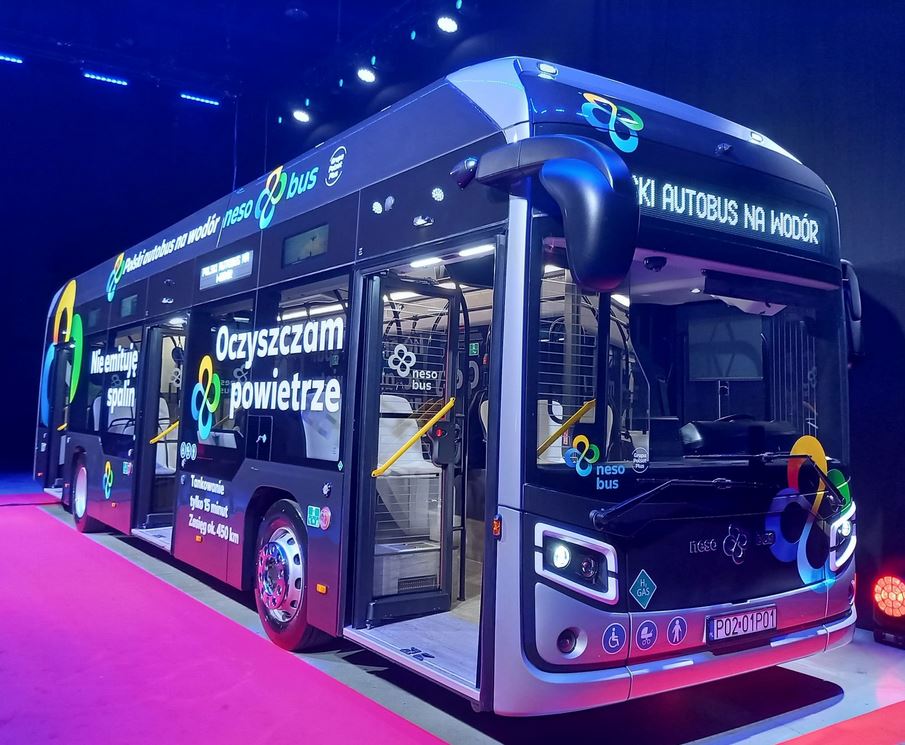NesoBus is a brand new, zero-emission, hydrogen-powered city bus from Poland. Powered by green hydrogen it is the most ecological city transport bus. It has been created by Polish designers and engineers, working together with partners from Europe and from other parts of the world. The bus is 12-meters-long and can carry up to 93 passengers, which includes 37 seats. Its operating range is around 450 km on one tank. It does not emit any exhaust fumes but purifies the air, with vapor being the only emission. NesoBus – the Polish hydrogen-powered bus – has been developed from scratch as a hydrogen-powered vehicle – it is not a transformed or modified combustion or battery-powered vehicle. Serial production is planned to start in 2023 in the factory which is being constructed in Swidnik, in eastern Poland.
We have developed the most ecological hydrogen-powered bus
Municipal transport causes extreme pollution in cities. Every type of air pollution can be the cause of various diseases – not only the ones affecting pulmonary system but also of strokes, cancer, heart attacks, allergies, etc. We have developed a hydrogen bus which is powered by green hydrogen and not only does not emit any exhaust fumes but additionally purifies the air while running.
NesoBus is an ideal solution for the inhabitants of cities – it eliminates emission of harmful substances – apart from CO2, such substances mainly include nitrogen oxide or PM 2.5 fine particulate matter.
How does a hydrogen-powered bus operate?
NesoBus, the Polish hydrogen-powered bus, is an electric vehicle – it has an electric motor. It generates electricity with the use of a fuel cell, using hydrogen as the fuel. The bus has its own “mini power plant.” Physically the hydrogen supplied from the tank is combined with the oxygen from the air and the electricity powering the motor is generated this way. There is no combustion process of any kind. Water vapor is the only thing that is emitted by the bus from the exhaust pipe as a result of combination of hydrogen and oxygen in the fuel cell. The water is fully distilled.
How does the hydrogen-powered bus purify the air?
NesoBus generates electricity as it runs, using oxygen from the air and combining it with hydrogen, from its tanks, in the fuel cell. There is no combustion process of any kind. The air must be fully purified by special filters so that the fuel cell can be supplied with pure oxygen. The oxygen is combined with hydrogen, thus leading to generation of energy which powers the electrical motor. NesoBus uses “green hydrogen,” emits not exhaust fumes and purifies the air.
Why NesoBus?
The brand name of our hydrogen bus, “Neso”, is an acronym of the Polish phrase ”Nie Emituje Spalin i Oczyszcza” (Does Not Emit Exhaust Fumes and Purifies the Air). NesoBus range is 450 km, refueling takes only 15 minutes. Thus the fully-ecological NesoBus does not waste many hours for battery charging. Instead of being parked for charging for many hours, it can drive continuously. NesoBus is very efficient – it uses 8 kg of hydrogen per 100 kilometers on the average. The capacity of its tanks is 37.5 kg of hydrogen which allows the bus to drive about 450 km on one tank. During the SORT-2 test the average consumption was 5.5 kg of hydrogen per 100 km.
NesoBus can also boast of excellent dimensions and capacity: length – 12 meters, width -2.55 meters, height – 3.4 meters and curb weight of less than 13 tons, which enables it to carry up to 93 passengers, including 37 seats.
The structure has been developed from scratch, with a hydrogen-powered bus in mind, and includes options to cater to the needs of respective cities and carriers.
NesoBus has been developed from scratch as a hydrogen-powered vehicle – it is not a transformed or modified combustion or battery-powered vehicle. The bus has been developed with hydrogen technology in mind and thanks to this the hydrogen tanks can be e.g. easily replaced to ones that operate at a higher pressure, thus increasing the vehicles operating range.
The bus has a modular structure, so we are able to accommodate it to the needs of specific cities. We employ 25 engineers who can adapt the bus to the needs of respective cities and carriers.
NesoBus has been developed by the best and the most experienced engineers from Poland, in cooperation from partners from Europe and other parts of the world.
The bus is made of very high quality components. Its exterior and interior have been designed by Torino Design of Italy, a company which specializes in design work for the automotive industry. Fuel cells come from the world leader, Ballard, while hydrogen tanks are manufactured by Hexagon, a specialist in this field.
Modern design, combined with the latest technologies, has led to the achievement of maximal technical performance parameters while not affecting the comfort of travelers.

Type approval
Following 65 days of intensive field and laboratory testing, which included 40 tests of various types, conducted in Poland and abroad, in April 2022 NesoBus has been granted the European vehicle type approval.
We plan to start serial production in Poland – for the needs of both, Polish and foreign markets
We are proud of building the factory in Poland, in the town of Swidnik – a region which has the traditions of automotive industry and offers access to very experienced and professional workforce. Our production capacity will be in excess of 100 buses per year. The factory will start operating already next year.
For more information go to:
nesobus.pl and polskiautobuswodorowy.pl
Contact:
PAK-PCE Polski Autobus Wodorowy Sp. z o.o.
biuro@polskiautobuswodorowy.pl
Technical specification
Technology
Latest technological and technical solutions have been applied:
- the dimensions are a response to the needs of municipal public transport – length: 12 meters, width: 2.55 m, height: 3.4 m i.e. typical dimensions for a city bus;
- state-of-the-art electrical drive with a fuel cell – solutions from the world’s best manufacturers of hydrogen systems;
- roof-mounted fuel cells, made of the most durable materials using latest technologies;
- electrical motors as the power units – coming from a proven manufacturer – mounted in the rear axle hub;
- hydrogen tanks providing driving range of up to 450 km;
- fast and short refueling process – takes up to 15 minutes only thanks to which the bus wastes no time for the long battery recharging process and downtimes.
Comfort and safety for passengers
- up to 93 passengers, including 37 seats;
- 3 wide doors;
- panoramic windows;
- efficient heating and air-conditioning system;
- WiFi installation and access to 5G;
- 3 double USB ports and 3 places for induction recharging of smartphones or laptops;
- 5 displays inside the passenger area, showing information for passengers
- 6 external displays on the sides of the bus, plus one on the front and one on the back;
- the bus is accommodated to carry disabled persons;
- on-board PA system;
- 360˚ monitoring;
- maximum soundproofing of the interior.
Safety
It is one of the safest vehicles (not only buses) on the market thanks to implementation of multi-level safeguards for the driver and the passengers:
- improved field of view for the driver thanks to employing bend lighting modular led headlights as well as dusk and rain sensors and 360 monitoring;°
- safety systems, including active traction control systems such as third generation EBS, , ABS, ASR, ESC, tire pressure sensors;
- connection between the collision sensors and the hydrogen leakage sensors.
Passenger information system
- information about the route;
- current weather information;
- local information, news from Poland and abroad;
- information on specific locations passed by the bus, e.g. historical monuments, shopping centers, schools, cinemas, theaters;
- additionally also advertisements.
Full comfort for the driver
- a comfortable driver seat with all necessary features;
- a spacious cabin;
- an on-board computer;
- an independent air-conditioning and heating system;
- two sun visors (on the left-hand side driver window and on the front windshield);
- operable driver’s window, heated windshield on the left-hand side;
- adjustable panel.
Range
Around 450 km – the bus can boast of bigger range than its competitors thanks to use of solutions which enable modular installation of 350 bar or 700 bar hydrogen tanks.
Structure
The structure is fully adapted to the needs of hydrogen-powered vehicles, which is possible thanks to having assumed, already at the design stage, that fuel cells, along with the accompanying devices, will be employed.

The animated presentation can be viewed HERE.

